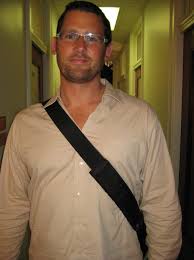Chamberlain charged with possession of an illegal device

Ryan Kelly Chamberlain II, a 1993 ISU alumnus, is wanted by the FBI for possession of explosive materials.
June 3, 2014
Ryan Kelly Chamberlain II, an ISU alumnus, former journalist and political consultant turned object of a federal manhunt, has been charged with possession of an illegal device.
On May 31, federal agents and hazardous material crews exacted a search warrant and entered Chamberlain’s apartment in search of what David J. Johnson, the FBI agent in charge, described as “items of great concern to us” in a press conference. In the days prior to the search, Johnson said that the FBI had received information that Chamberlain was in possession of “certain materials.”
According to a criminal complaint against Chamberlain, a rust-colored messenger bag adjacent to Chamberlain’s dining room table was found. After conducting an X-ray analysis of the bag, FBI bomb technicians inspected the contents.
Inside the messenger bag, according to the criminal complaint, was a glass jar containing batteries, a “powdery green substance” and a model rocket motor, which was lodged within the green powdery substance.
The criminal complaint states that, “the insertion of the model rocket motor into the green powdery substance is significant, since rocket motors are known to ‘burn’ at extreme temperatures, creating an efficient method of fully igniting explosive material, which the FBI bomb technicians believe the green powdery substance to be.”
Also in the bag was an “electric match,” an assortment of ball bearings and screws, a wire which extended from the glass jar attached to the metal lid of the jar and a circuit board which was configured as a remote control receiver.
The bomb technicians that analyzed the contents deemed them to be an illegal destructive device and that the device was “designed to maim or kill a human being or human beings.”
After 14 hours inside Chamberlain’s apartment, the FBI launched a nationwide search and called upon law enforcement and citizens across the nation to aid in its search for Chamberlain, who at the time was said to be armed and dangerous.
On June 2, Chamberlain posted a letter via social media titled “Goodbye,” which chronicled his struggles in his professional and personal life. Chamberlain also tweeted that he was not armed or dangerous.
Chamberlain was later listed as no longer an immediate public threat, but Greg Suhr, the chief of police for the San Francisco Police Department, said that they still believed they were dealing with a “very dangerous and desperate person.”
At 6:30 p.m. Pacific time on June 3, Suhr said that a citizen had reported seeing a man that resembled Chamberlain at an area near the Golden Gate Bridge. Two officers in the area responded and confirmed the tip.
Suhr said that Chamberlain, upon seeing the officers, attempted to flee and the officers gave chase before catching Chamberlain. A brief struggle ensued before Chamberlain was arrested.
This morning, Chamberlain was told that he is being charged with possession of an illegal device. If found guilty, Chamberlain could face up to 10 years in prison and a fine of no more than $10,000.
















